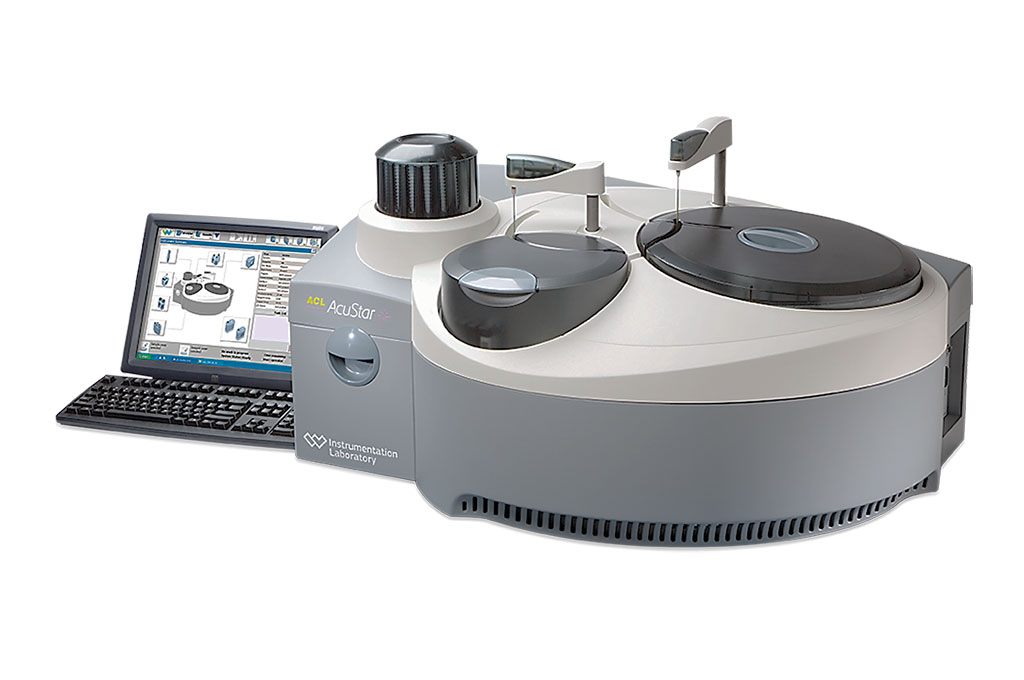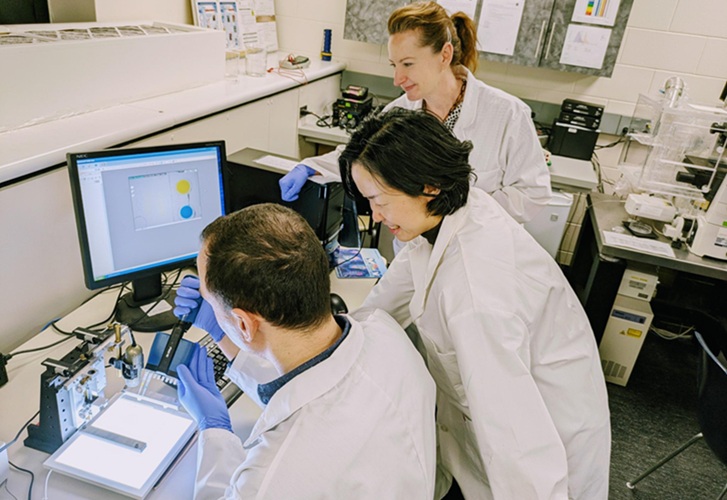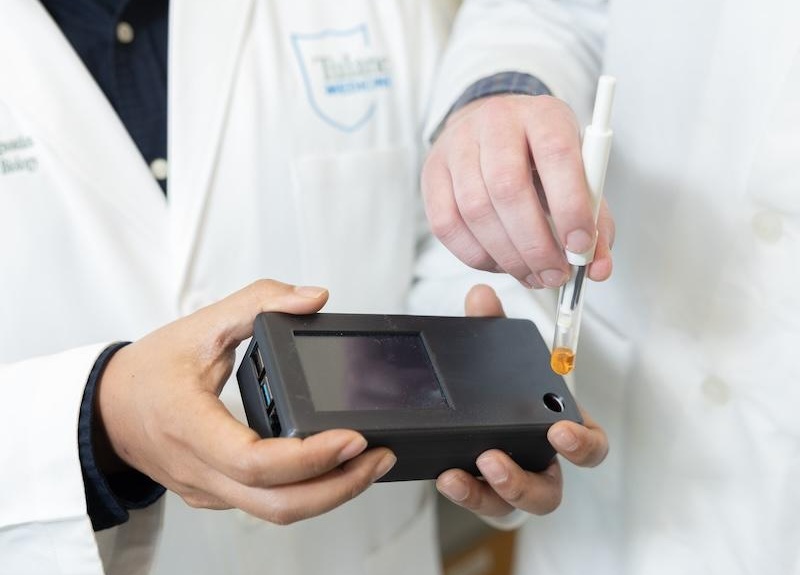PF4 Immunoassays Investigated in Vaccine-Induced Thrombotic Thrombocytopenia
|
By LabMedica International staff writers Posted on 07 Jun 2021 |

Image: The AcuStar Hemostasis Testing System (Photo courtesy of Werfen)
Post-vaccination embolic and thrombotic events, also termed vaccine-induced prothrombotic immune thrombocytopenia (VIPIT) or vaccine-induced immune thrombotic thrombocytopenia (VITT) are rare types of blood clotting events that were initially observed in a very small number of people who had previously received the COVID-19 vaccine.
Platelet factor 4 (PF4) is a small cytokine belonging to the CXC chemokine family that is also known as chemokine (C-X-C motif) ligand 4 (CXCL4). This chemokine is released from alpha-granules of activated platelets during platelet aggregation, and promotes blood coagulation by moderating the effects of heparin-like molecules. Due to these roles, it is predicted to play a role in wound repair and inflammation.
Medical Scientists at the Toulouse University Hospital (Toulouse, France) and their colleagues analyzed plasma samples from nine patients (median age, 44 years; seven females, two males) with suspected VITT after vaccination with ChAdOx1 nCoV-19 (AstraZeneca, Cambridge, UK). The most common events were cerebral vein thrombosis (n = 6) and splanchnic vein thrombosis (n = 5). All the patients had severe thrombocytopenia (median platelet count nadir, 29,000/mm3; range, 9 to 61,000) except for one woman with both cerebral vein thrombosis and splanchnic vein thrombosis.
Two rapid immunoassays widely used for the diagnosis of heparin-induced thrombocytopenia, STic Expert HIT (Stago Diagnostica, Asnières-sur-Seine, France) and HemosIL AcuStar HIT-IgG (Instrumentation Laboratory, Bedford, MA, USA) were performed on plasma samples to detect PF4-specific antibodies, and the results were negative in all the patients. Two other rapid tests had been performed in some patients by the referring laboratories and were negative, except in one patient, who had an equivocal result.
The team also tested all plasma samples with three different PF4-specific enzyme-linked immunosorbent assays, variable results were obtained. Significant levels of immunoglobulin (Ig)G antibodies to PF4 were detected in seven patients only by the assay that used PF4–poly(vinyl sulfonate) (PVS) complex as the antigenic target. In addition, optical density values were variable and lower than those previously reported with a similar test. The diagnosis of VITT was confirmed by PF4–serotonin release assay in all seven patients with IgG antibodies to PF4–PVS, whereas a standard serotonin release assay was negative in two patients.
The authors concluded that their results provide further support to show that rapid immunoassays should be avoided in the detection of PF4-specific antibodies in patients with suspected VITT. Therefore, the use of a sensitive, quantitative, immunologic test is strongly recommended, because according to the recently proposed algorithm, nonheparin anticoagulants should be preferred when clinically significant levels of anti-PF4 antibodies are detected. The study was published on May 19, 2021 in The New England Journal of Medicine.
Related Links:
Toulouse University Hospital
AstraZeneca
Stago Diagnostica
Instrumentation Laboratory
Platelet factor 4 (PF4) is a small cytokine belonging to the CXC chemokine family that is also known as chemokine (C-X-C motif) ligand 4 (CXCL4). This chemokine is released from alpha-granules of activated platelets during platelet aggregation, and promotes blood coagulation by moderating the effects of heparin-like molecules. Due to these roles, it is predicted to play a role in wound repair and inflammation.
Medical Scientists at the Toulouse University Hospital (Toulouse, France) and their colleagues analyzed plasma samples from nine patients (median age, 44 years; seven females, two males) with suspected VITT after vaccination with ChAdOx1 nCoV-19 (AstraZeneca, Cambridge, UK). The most common events were cerebral vein thrombosis (n = 6) and splanchnic vein thrombosis (n = 5). All the patients had severe thrombocytopenia (median platelet count nadir, 29,000/mm3; range, 9 to 61,000) except for one woman with both cerebral vein thrombosis and splanchnic vein thrombosis.
Two rapid immunoassays widely used for the diagnosis of heparin-induced thrombocytopenia, STic Expert HIT (Stago Diagnostica, Asnières-sur-Seine, France) and HemosIL AcuStar HIT-IgG (Instrumentation Laboratory, Bedford, MA, USA) were performed on plasma samples to detect PF4-specific antibodies, and the results were negative in all the patients. Two other rapid tests had been performed in some patients by the referring laboratories and were negative, except in one patient, who had an equivocal result.
The team also tested all plasma samples with three different PF4-specific enzyme-linked immunosorbent assays, variable results were obtained. Significant levels of immunoglobulin (Ig)G antibodies to PF4 were detected in seven patients only by the assay that used PF4–poly(vinyl sulfonate) (PVS) complex as the antigenic target. In addition, optical density values were variable and lower than those previously reported with a similar test. The diagnosis of VITT was confirmed by PF4–serotonin release assay in all seven patients with IgG antibodies to PF4–PVS, whereas a standard serotonin release assay was negative in two patients.
The authors concluded that their results provide further support to show that rapid immunoassays should be avoided in the detection of PF4-specific antibodies in patients with suspected VITT. Therefore, the use of a sensitive, quantitative, immunologic test is strongly recommended, because according to the recently proposed algorithm, nonheparin anticoagulants should be preferred when clinically significant levels of anti-PF4 antibodies are detected. The study was published on May 19, 2021 in The New England Journal of Medicine.
Related Links:
Toulouse University Hospital
AstraZeneca
Stago Diagnostica
Instrumentation Laboratory
Latest Hematology News
- New Scoring System Predicts Risk of Developing Cancer from Common Blood Disorder
- Non-Invasive Prenatal Test for Fetal RhD Status Demonstrates 100% Accuracy
- WBC Count Could Predict Severity of COVID-19 Symptoms
- New Platelet Counting Technology to Help Labs Prevent Diagnosis Errors
- Streamlined Approach to Testing for Heparin-Induced Thrombocytopenia Improves Diagnostic Accuracy
- POC Hemostasis System Could Help Prevent Maternal Deaths
- New Test Assesses Oxygen Delivering Ability of Red Blood Cells by Measuring Their Shape
- Personalized CBC Testing Could Help Diagnose Early-Stage Diseases in Healthy Individuals
- Non-Invasive Test Solution Determines Fetal RhD Status from Maternal Plasma
- First-Of-Its-Kind Smartphone Technology Noninvasively Measures Blood Hemoglobin Levels at POC

- Next Gen CBC and Sepsis Diagnostic System Targets Faster, Earlier, Easier Results
- Newly Discovered Blood Group System to Help Identify and Treat Rare Patients
- Blood Platelet Score Detects Previously Unmeasured Risk of Heart Attack and Stroke
- Automated Benchtop System to Bring Blood Testing To Anyone, Anywhere
- New Hematology Analyzers Deliver Combined ESR and CBC/DIFF Results in 60 Seconds
- Next Generation Instrument Screens for Hemoglobin Disorders in Newborns
Channels
Clinical Chemistry
view channel
‘Brilliantly Luminous’ Nanoscale Chemical Tool to Improve Disease Detection
Thousands of commercially available glowing molecules known as fluorophores are commonly used in medical imaging, disease detection, biomarker tagging, and chemical analysis. They are also integral in... Read more
Low-Cost Portable Screening Test to Transform Kidney Disease Detection
Millions of individuals suffer from kidney disease, which often remains undiagnosed until it has reached a critical stage. This silent epidemic not only diminishes the quality of life for those affected... Read more
New Method Uses Pulsed Infrared Light to Find Cancer's 'Fingerprints' In Blood Plasma
Cancer diagnoses have traditionally relied on invasive or time-consuming procedures like tissue biopsies. Now, new research published in ACS Central Science introduces a method that utilizes pulsed infrared... Read moreMolecular Diagnostics
view channel
Simple Blood Test Improves Heart Attack and Stroke Risk Prediction
Troponin is a protein found in heart muscle cells that is released into the bloodstream when the heart is damaged. High-sensitivity troponin blood tests are commonly used in hospitals to diagnose heart... Read more
Blood Biomarker Test Could Detect Genetic Predisposition to Alzheimer’s
New medications for Alzheimer’s disease, the most common form of dementia, are now becoming available. These treatments, known as “amyloid antibodies,” work by promoting the removal of small deposits from... Read more
Novel Autoantibody Against DAGLA Discovered in Cerebellitis
Autoimmune cerebellar ataxias are strongly disabling disorders characterized by an impaired ability to coordinate muscle movement. Cerebellar autoantibodies serve as useful biomarkers to support rapid... Read more
Gene-Based Blood Test Accurately Predicts Tumor Recurrence of Advanced Skin Cancer
Melanoma, an aggressive form of skin cancer, becomes extremely difficult to treat once it spreads to other parts of the body. For patients with metastatic melanoma tumors that cannot be surgically removed... Read moreImmunology
view channel
Stem Cell Test Predicts Treatment Outcome for Patients with Platinum-Resistant Ovarian Cancer
Epithelial ovarian cancer frequently responds to chemotherapy initially, but eventually, the tumor develops resistance to the therapy, leading to regrowth. This resistance is partially due to the activation... Read more
Machine Learning-Enabled Blood Test Predicts Immunotherapy Response in Lymphoma Patients
Chimeric antigen receptor (CAR) T-cell therapy has emerged as one of the most promising recent developments in the treatment of blood cancers. However, over half of non-Hodgkin lymphoma (NHL) patients... Read moreMicrobiology
view channel
Handheld Device Delivers Low-Cost TB Results in Less Than One Hour
Tuberculosis (TB) remains the deadliest infectious disease globally, affecting an estimated 10 million people annually. In 2021, about 4.2 million TB cases went undiagnosed or unreported, mainly due to... Read more
New AI-Based Method Improves Diagnosis of Drug-Resistant Infections
Drug-resistant infections, particularly those caused by deadly bacteria like tuberculosis and staphylococcus, are rapidly emerging as a global health emergency. These infections are more difficult to treat,... Read more
Breakthrough Diagnostic Technology Identifies Bacterial Infections with Almost 100% Accuracy within Three Hours
Rapid and precise identification of pathogenic microbes in patient samples is essential for the effective treatment of acute infectious diseases, such as sepsis. The fluorescence in situ hybridization... Read morePathology
view channel
Spit Test More Accurate at Identifying Future Prostate Cancer Risk
Currently, blood tests that measure the level of a protein called prostate-specific antigen (PSA) are commonly used to identify men at higher risk for prostate cancer. This test is typically used based... Read moreDNA Nanotechnology Boosts Sensitivity of Test Strips
Since the Covid-19 pandemic, most people have become familiar with paper-based rapid test strips, also known as lateral flow immunoassays (LFIAs). These tests are used to quickly detect biomarkers that... Read more
Novel UV and Machine Learning-Aided Method Detects Microbial Contamination in Cell Cultures
Cell therapy holds great potential in treating diseases such as cancers, inflammatory conditions, and chronic degenerative disorders by manipulating or replacing cells to restore function or combat disease.... Read moreTechnology
view channel
Disposable Microchip Technology Could Selectively Detect HIV in Whole Blood Samples
As of the end of 2023, approximately 40 million people globally were living with HIV, and around 630,000 individuals died from AIDS-related illnesses that same year. Despite a substantial decline in deaths... Read more
Pain-On-A-Chip Microfluidic Device Determines Types of Chronic Pain from Blood Samples
Chronic pain is a widespread condition that remains difficult to manage, and existing clinical methods for its treatment rely largely on self-reporting, which can be subjective and especially problematic... Read more
Innovative, Label-Free Ratiometric Fluorosensor Enables More Sensitive Viral RNA Detection
Viruses present a major global health risk, as demonstrated by recent pandemics, making early detection and identification essential for preventing new outbreaks. While traditional detection methods are... Read moreIndustry
view channel
Cepheid and Oxford Nanopore Technologies Partner on Advancing Automated Sequencing-Based Solutions
Cepheid (Sunnyvale, CA, USA), a leading molecular diagnostics company, and Oxford Nanopore Technologies (Oxford, UK), the company behind a new generation of sequencing-based molecular analysis technologies,... Read more
Grifols and Tecan’s IBL Collaborate on Advanced Biomarker Panels
Grifols (Barcelona, Spain), one of the world’s leading producers of plasma-derived medicines and innovative diagnostic solutions, is expanding its offer in clinical diagnostics through a strategic partnership... Read more


















